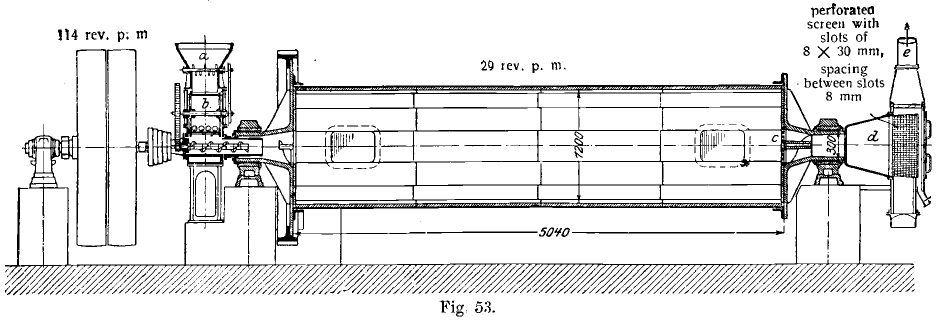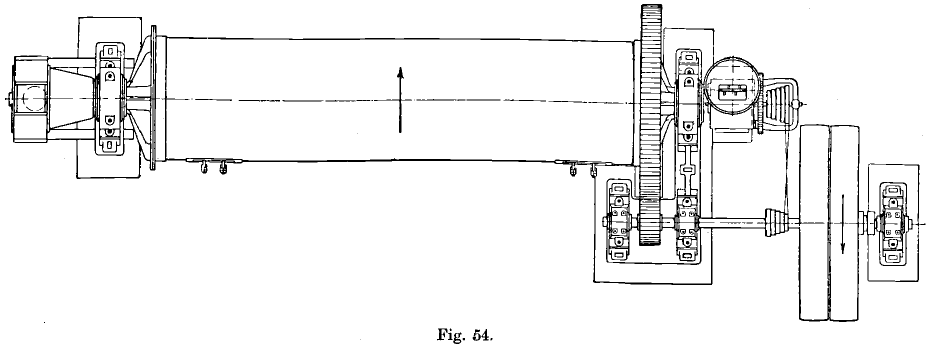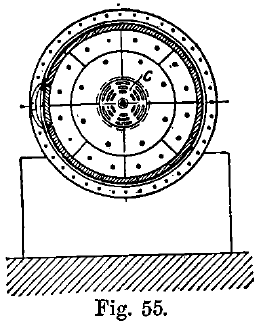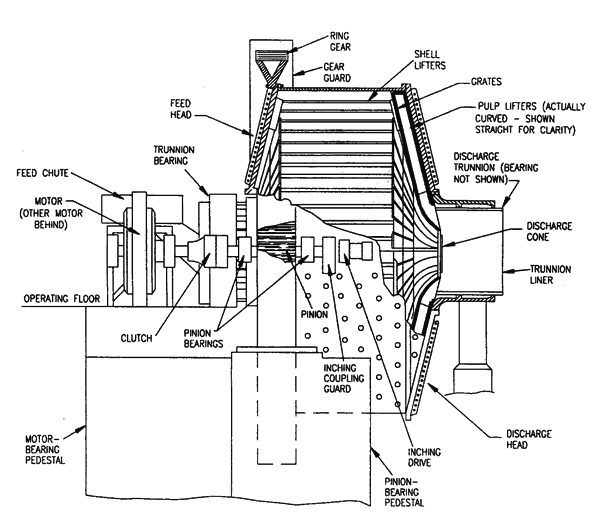Tube Mills consist of revolving cylinders, the interior of which is perfectly plain. They contain a number of hard balls. They differ from ball mills essentially in having the inlet for ore at one end and the outlet at the other, and in the absence of provision in the machine itself for the return of uncrushed material (oversize). It is therefore necessary for the cylinders to be of greater length than in ball mills. The number of balls used is also much larger, and, according to one view, the reduction of the ore is effected by grinding rather than by impact, as in ball mills, so that this constitutes another essential difference.
The cylinders are from 3½ to 6 feet in diameter, and from 13 to 26 feet long. They consist of welded steel with cast-iron or steel heads.
The lining consists of hard wood, chilled cast-iron, hard homogeneous iron, steel, manganese steel, quartzite, or flint (silex). Of these, wooden blocks were stated to be worn out in three days in South Africa, and cast-iron plates in three weeks, but in this case coarse ore was said to have been treated. Manganese steel linings lasted fifteen months at Kalgoorlie, and chilled iron liners from seven to ten months. The great cost of manganese steel made it less economical than hard iron.
The quartzite lining of the Davidsen Mill consists of blocks of quartzite, 8 inches by 4 inches and 2 inches thick, cemented in place. These linings are supposed to last for two or three years or even longer. The wear of flint linings is equal to the wear of the flint balls according to Dr. Diehl, but is far less according to S. Robinson. In the Smidth-Davidsen mills the linings are not bolted through the cylinder, but in other mills bolts are used.
The balls usually consist of flint, although the use of steel balls has been advocated. The size varies up to 3 or 4 inches in diameter. According to M. Davidsen, in wet crushing large pebbles wear less rapidly than small pebbles and crush as finely.
The larger the pebbles the coarser may be the ore fed in. For dry grinding small pebbles of 1 to 2 inches in diameter are preferable. The Greenland flints, found on the Danish shores, are more durable than the chalk flints of the French coast. The mill is best kept about half filled with pebbles, the weight of pebbles added to a mill being 44 lbs. per cubic foot of interior volume. The consumption of flints is about 1 lb. per ton of ore treated.
The speed of revolution of tube mills varies with the diameter. Krupp uses the formula 32/√D for the correct number of revolutions per minute, where D = internal diameters in metres. The Davidsen formula is 200/√D, where D is the diameter in inches.
These two formulae are almost identical and would give about 26 revolutions per minute for a mill of 5 feet in diameter. In practice a somewhat higher rate of speed is used, amounting generally to 2 or 3 revolutions per minute more than corresponds to the formulae given above.
The power required, according to Davidsen, is given by the formula P = 0.15 N, where P is the number of H.P. and N the internal capacity of the mill in cubic feet. According to James, the power required is less for wet grinding than for dry grinding.
The capacity of tube mills depends on the size of the material supplied to them, and on the fineness of the product. The amount of grinding done and the fineness of the product depend on the rate of feed and the length of the tube, as well as on the hardness of the ore. According to Gruessner, at the Hannan’s Star Mill, Kalgoorlie, the ore from two No. 5 dry ball mills was treated wet in a tube mill 16 feet 5 inches long and 3 feet 11 inches in diameter. The ball mills crushed 78 tons per day and, after classification, the coarser part of this, amounting to 38 tons, was ground to about 250 mesh in the tube mill. The pulp fed into the mill contained: coarser than 40 mesh, 20.5 per cent.; 40 to 60 mesh, 43.8 per cent.; 60 to 100 mesh, 28.1 per cent.; 100 to 150 mesh, 7’6 per cent. The product was not examined, but returned to the spitzkasten and re-classified, the sands returning to the mill. The overflow (final product) contained : coarser than 100 mesh, 0.7 per cent.; 100 to 150 mesh, 4 per cent.; finer than 150 mesh, 95.3 per cent. The power consumption of the 16-foot mill was 30 H.P.
The wear of the flints and liners is closely connected with the amount of the feed, and also the thickness of the pulp. The best results are obtained by paying close attention to these points, but no broad rules have been laid down. By repeated trials the best methods for particular ores have been arrived at in certain mills. S. Robinson states that the pulp should be very thick, containing not more than 33 per cent, of water, and Trewartha- James insists on a good layer of, pulp between the flints, and as a protection to the lining. Otherwise the flints grind one another and the lining instead of the ore. Alfred James points out that good results have been obtained with a pulp of 50 per cent, thickness. In the Robinson Deep Mine the water was removed from the pulp as much as possible. By bringing the spitzkasten directly over the feed funnel of the tube mill a mixture of 75 parts of water with 100 of ore was obtained.
A section of a Tube Mill is shown in Fig. 52. It may be seen that the feed is through the hollow trunnion, but the discharge is through a grating near the periphery. In other mills the discharge, like the feed, is central. It is stated that this is less advantageous, resulting in a higher percentage of oversize leaving the mill uncrushed.
 The Krupp Tube Mill differs from the Smidth-Davidsen Mill, largely in the method of charging and discharging the pulp. Fig. 53 is a longitudinal section of a mill for dry crushing, Fig. 54 a plan of the mill, and Fig. 55 a cross-section of the tube or drum, showing the discharge apertures at c. The drum is 1.2 metres (3 feet 11¼ inches) in diameter, and 5 metres (16 feet 5 inches) long, inside measurement, and revolves at the rate of 29 revolutions per minute. The drum consists of sheet iron 12 mm. (15/32 inch) thick, has cast-steel ends, and is lined with hard cast-iron plates. The grinding balls are introduced through a manhole, whilst the material to be crushed is fed and discharged through the hollow trunnions cast together with the end walls. The material passes first of all into the hopper, a, in which a studded shaft rotates. A longitudinally-grooved drum, b, regulates the supply of material. This drum is rotated by toothed-wheel gearing and a pair of five-step pulleys at different speeds, and contains a few balls which serve to shake the drum, and thereby secure the emptying of its grooves.
The Krupp Tube Mill differs from the Smidth-Davidsen Mill, largely in the method of charging and discharging the pulp. Fig. 53 is a longitudinal section of a mill for dry crushing, Fig. 54 a plan of the mill, and Fig. 55 a cross-section of the tube or drum, showing the discharge apertures at c. The drum is 1.2 metres (3 feet 11¼ inches) in diameter, and 5 metres (16 feet 5 inches) long, inside measurement, and revolves at the rate of 29 revolutions per minute. The drum consists of sheet iron 12 mm. (15/32 inch) thick, has cast-steel ends, and is lined with hard cast-iron plates. The grinding balls are introduced through a manhole, whilst the material to be crushed is fed and discharged through the hollow trunnions cast together with the end walls. The material passes first of all into the hopper, a, in which a studded shaft rotates. A longitudinally-grooved drum, b, regulates the supply of material. This drum is rotated by toothed-wheel gearing and a pair of five-step pulleys at different speeds, and contains a few balls which serve to shake the drum, and thereby secure the emptying of its grooves.

 The material supplied is conveyed by a screw into the hollow trunnion, which is conical inside, enlarging towards the drum. Here it is scooped up by two helical blades which pass it into the drum, and prevent the balls from being thrown out of the mill. The ore then passes through the drum and through the grating, c (Figs. 55 and 56), into the outlet trunnion.
The material supplied is conveyed by a screw into the hollow trunnion, which is conical inside, enlarging towards the drum. Here it is scooped up by two helical blades which pass it into the drum, and prevent the balls from being thrown out of the mill. The ore then passes through the drum and through the grating, c (Figs. 55 and 56), into the outlet trunnion.

The grating, c, is provided with curved slots of about 25 millimetres (1 inch) in width. The material passes therefrom into a hopper, d, attached to the trunnion, A perforated screen is connected to the hopper. The slots of the screen are 8 millimetres (5/16 inch) in width and 30 millimetres (1 3/16 inches) in length ; they permit the sufficiently-crushed material to drop through, whilst very hard particles which are not crushed, and splinters of the flintstone balls, are retained and subsequently drop out on the right side (Fig. 53). The sieve is enclosed by a casing, out of which the air is drawn by means of the pipe, e, so that air enters the drum at all other apertures. This is to avoid loss by dusting.
Theory of Tube Mills
According to H. Fischer, who made experiments for the Krupp firm, the tube mill does its work mainly by impact, not by grinding. Glass drums and drums with gratings at the ends were constructed, and the action in the interior observed. One such drum 1 metre (39.3 inches) in diameter was filled with flint balls to a height of 450 mm. (17.7 inches) and rotated. Prof. Fischer found that, at the slow speed of rotation of 21 to 23 revolutions per minute, the balls rolled slowly down the slope. At 32 revolutions per minute (the correct speed for a tube of this diameter, according to the formulae given above) the charge of balls had become looser, and their bulk was considerably more than half the capacity of the drum. At 34 revolutions (Fig. 56) the balls (A A1) next the drum were carried up without sliding or rolling on the drum, until at a certain height they separated from it and were projected outwards in a curve, falling near the other side of the charge of pebbles. Prof. Fischer concluded that at this speed each ball fell separately, crushing and spattering the cushion of ore between it and the balls that had previously fallen. The other layers of pebbles described similar but shorter courses, and a hollow space, D, continually varying in size and shape, was always recognisable. The blow struck by each ball of the outer layer was a sliding one, the relative velocity of two balls at the moment of impact being 3.5 metres per second in the line joining their centres, and 1.2 metres per second in the direction at right angles to this. These velocities give some measure of the respective effects of the impact and grinding actions.
It is, as yet, too soon to say how far these conclusions of Prof. Fischer would apply to the conditions of actual work in practice. According to one view, in the mill with peripheral discharge, the sands pass right through the mass of the flints, which continually roll over and rub against one another, and the crushing is presumably affected by abrasion and not by impact (see Fig. 52). A. W. Warwick’s view is that, with a small charge of pebbles and a high velocity of revolution, the impact effect would predominate, and with a large charge of pebbles and a low velocity the grinding effect would be paramount. The charge of pebbles in the Smidth-Davidsen mill is 44 lbs. per cubic foot, and in the Krupp mill from 50 to 55 lbs. per cubic foot.
H. A. White agrees with Fischer that the pulverising action is due almost entirely to actual impact of the falling balls in dry crushing, but points out that where the tube is half full of water the effect of impact is of less importance. A ball falling into 2 or 3 feet of water will not strike the bottom with enough force to do much crushing, and in this case it is probable that the grinding action between the balls will do a great proportion of the work.
In connection with this conclusion, it is to be remembered that the best results have been obtained with very thick pulp, containing 50 per cent., or even less, of water. In a tube mill containing such pulp there would be no “free” water for the balls to fall through, and it is likely enough that the pulverising action would be almost the same as in dry crushing.
White finds that the average fall of the balls is at a maximum, if the mill is half-filled with balls, when the number of revolutions per minute, N, is equal to 34.22/√D, where D is the diameter of the mill expressed in metres. The formulae of the manufacturers given above (p. 203) correspond to a slightly lower speed of revolution, but White’s result, obtained by calculation, gives the same speed as that at which Fischer found by experiment that each ball fell separately.
S. H. Pearce found at the Glen Deep Mill that the introduction of a new lining, made of rings of manganese, was attended with a cessation of the usual rumbling noise. There was a tendency for the pebbles to wear flat, and the crushing efficiency dropped. After a time the rumbling began again, and the crushing efficiency increased. He supposed that the pebbles slipped on the new smooth surface, but that the lining acquired a rough surface by wear, and the pebbles were raised higher, causing crushing [by impact] instead of reduction by grinding.
W. R. Dowling confirms this view from the experience at the Robinson Deep Mill. He found that a silex lining takes a larger feed and gives a finer ground product than manganese steel, owing to the absence of sliding action when the former is used.
